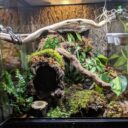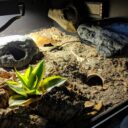Our last series of articles focused on a bioactive vivarium for a gargoyle gecko. This series is going to apply the same technique to a more arid habitat, one suitable for a leopard gecko.
All bioactive enclosures have the same basic requirements, but the needs of your main inhabitant dictate the ways in which you can support bioactivity. Many people have claimed it impossible to create a bioactive desert terrarium, but let’s not forget that life persists all over the earth, even in the harshest terrain! It’s a matter of designing for the conditions.
Design Considerations
Needs of the Leopard Gecko
Leopard geckos are hands down my favorite species. This checklist is based upon caresheet research and experiences with my own geckos:
- Dark crevices — Leopard geckos prefer to shelter during the day, so it is vital to provide hiding places away from light. Multiple locations allow for a choice of temperature.
- Humid hide — These geckos clearly are not armored lizards. Their skin is thin and soft, and they are highly susceptible to dehydration. A common mistake in their keeping is not providing a humid retreat. Humid areas also ease shedding and provide females with places to lay eggs.
- Heat — Unlike many desert lizards, leopard geckos do not bask in direct sun. While they receive some indirect light exposure, they rely on heat absorbed by the terrain to warm themselves. Some keepers successfully provide heat with basking bulbs, but this differs from their natural habitat, where the vast desert terrain absorbs energy from the sun during the day and radiates it back upward for a period while the sun is setting. In contrast, our small captive enclosures have lights full on with no dimming and a small amount of substrate that rapidly cools after lights out. Radiant heat from the ground is best replicated using an under-tank heater or, when the substrate is too deep to conduct heat to the surface, a ceramic heat emitter or deep heat projector.
- UVB lighting — UVB light helps geckos synthesize vitamin D and absorb calcium, and low levels replicate the indirect rays available to leopard geckos at dusk and dawn. I have observed my own geckos basking at oblique angles during the twilight hours or engaging in “tail basking” by leaving their tail exposed to light while in a hide during the day. Lighting, UVB or other, also serves to provide a day-night cycle.
Requirements for Bioactivity
- Substrate to support plants and invertebrates — One of the more difficult aspects of an arid enclosure is providing substrate that is able to support bioactivity. You can mix in organic matter to some extent, but too much and the enclosure ceases to be a desert! This problem can be addressed by providing a different substrate mixture for plants and a refuge for invertebrates that provides more humidity.
- Plants — Plant species for an arid enclosure cannot require much humidity to thrive, so succulents and grasses are your best bets. Although cacti are appealing, you should choose types without large spines that could injure your gecko. Providing plant lighting will allow you a broader choice of species, as most desert plants require bright light.
- Custodians — Desert enclosures are not suitable for many isopod and springtail species due to limited moisture. It may be possible to support them with a deeply buried humid layer of substrate, but you will have better luck with invertebrates that can tolerate dryness: pill bugs and beetles, like mealworms or dermestids. I have also had positive results with colonizing book lice (psocids), which I suspect come from collected leaf litter.
Leopard Geckos in the Wild
To best suit your species, take your inspiration from their habits in the wild. Leopard geckos are tolerant of many types of drier habitat, from montane regions to rocky deserts, grasslands, and dry forests. The various subspecies have a range that runs through the Middle East and into India. They aggregate in rocky, gravelled areas where humid crevices are present, even making use of man-made structures. The majority of their habitats have sparse vegetation, in the form of shrubs, grasses, or trees, but they are also found in forests.
Ground temperatures 82.4 to 89.6 °F are most preferred by the species, while ideal air temperatures range from high 60s to low 80s. Their favorite resting places during the day are 40-56% humidity, and geckos are most active on hot and humid nights where humidity is 75-90%. Individuals don’t always have access to these ideal ranges in the wild; seasonal temperatures can be cold enough to induce dormancy or peak above 100 °F. In captivity, we seek to maintain their preferred conditions as much as possible to minimize stress, but keepers may also opt to provide a cooler period.
Leopard geckos are both nocturnal and crepuscular, being active during the night and twilight hours. They rest during the day in their humid hiding locations and then emerge to high perches at dusk. They will disperse to hunt and return to their selected perch before dawn. Because these geckos require humid microclimates, they are often found in loose colonies. Competition between individuals is high.
This species is highly affiliated with dry, rocky terrain that has humid crevices in which to shelter and seasonal periods of high humidity. This is vital to remember when designing an appropriate captive habitat. A pure sand substrate is not natural for them. Without the proper air humidity, they will suffer from dehydration. And their preferred temperature ranges indicate that substrate temperature should be higher than air temperature during the evening hours.
Next up: Vivarium Construction
Join us next week for the article about leopard gecko vivarium construction!
Resources
- Azart, Aliza. 2013. “Interview with Karsten Griesshammer: Field Herping In Iran.” Gecko Time (blog). April 23, 2013.
http://geckotime.com/interview-with-karsten-griesshammer-field-herping-in-iran/ - Khan, Muhammad Sharif. 2006. “Natural history and biology of hobbyist choice leopard gecko Eublepharis macularius.” Reptilia 45: 22-27.
———. 1999. “Herpetology of habitat types of Pakistan.” Pakistan journal of zoology 31, no. 3: 275-289.
- Seufer, Hermann, Yuri Kaverkin, and Andreas Kirschner, Ed. 2005. “Eublepharis macularius.” In The Eyelash Geckos: Care, Breeding and Natural History, 110-126. Karlsruhe: Kirschner & Seufer Verlag.
- Woods, Vicki. 2001. “Eublepharis macularius.” Animal Diversity Web. Accessed July 11, 2019.
https://animaldiversity.org/accounts/Eublepharis_macularius/




Have watched all the time and work that is put into these habitats. Lucky geckos and skink to have such a caring owner. Do the best you can do,if you choose to have them depend on you for care. They are not a toy for your kids. They need to be cared for properly. Thank you.